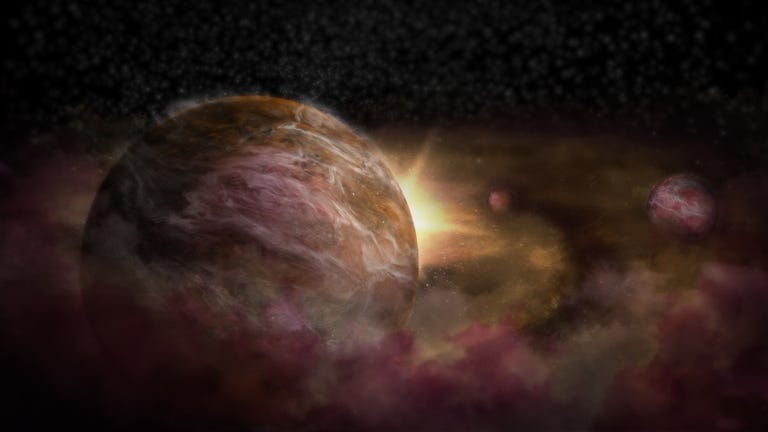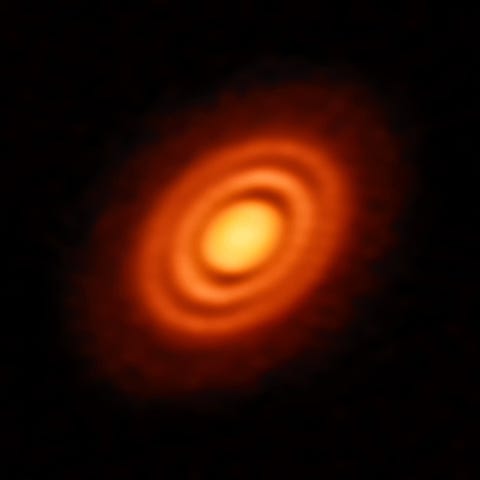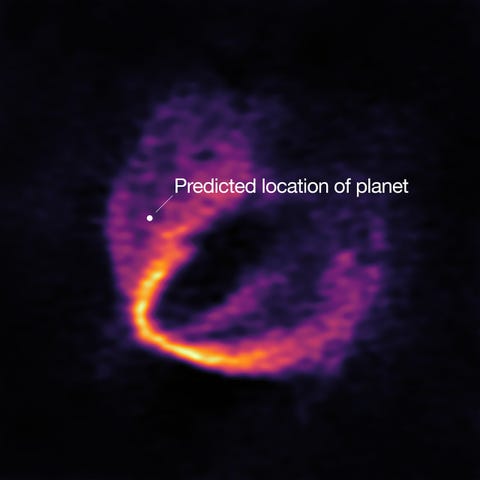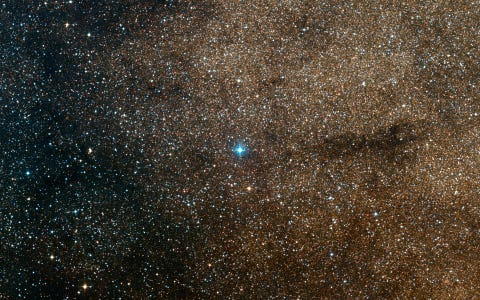Three Newborn Planets Discovered Around an Infant Star
A brand new method of exoplanet detection makes it possible to spot planets just as they are forming in a disk of gas and dust swirling around young stars.
By Jay Bennett
NRAO/AUI/NSF; S. DAGNELLO
The star HD 163296 is a baby, only 4 million years old. While that may not sound very young, it's less than a thousandth of the age of the sun—young enough that the star still has its protoplanetary disk. This swirling mass of gas and dust encircling the star is leftover material that was not consumed by the star itself when it coalesced and sparked the fires of nuclear fusion at its core.
Planets are born within these protoplanetary disks as material clumps together to form bigger and bigger bodies, eventually soaking up all the gas and dust or otherwise blowing it out of the system. But until now, spotting infant planets forming in the haze has been a major challenge.
Two studies published today in the Astrophysical Journal Letters outline a novel technique to discover protoplanets, one that was used to provide convincing evidence that three large planets are forming in the disk around HD 163296, about 330 light-years away toward the constellation Sagittarius. Using the Atacama Large Millimeter Array (ALMA), consisting of 66 radio telescopes in northern Chile, astronomers were able to precisely measure the velocities of gases swirling in HD 163296's protoplanetary disk.
When the disk material hits a large object, it creates swirls of gas (specifically carbon monoxide) that have been compared to eddies in a river caused by obstructing rocks. ALMA can spot these eddies in the protoplanetary disk by measuring slight Doppler shifts as the gases move toward and away from us.
"We developed a new technique to measure extremely precise velocities of the gas around the star," Richard Teague, an astronomer at the University of Michigan and lead author of one of the studies, told Popular Mechanics in an email. "We are able to achieve an accuracy of less than 5 m/s for gas which is rotating a few km/s!"

The protoplanetary disk surrounding HD 163296, imaged by ALMA.
ESO/ALMA/NAOJ/NRAO/AUI/NSF/A. ISELLA/B. SAXTON
Astronomers have suspected that there are large planets forming around HD 163296 for a couple years. In 2016, researchers at Rice University in Houston studied rings and gaps that are present in the protoplanetary disk and concluded that the gaps were likely cleared by orbiting planets. However, other natural processes in the dynamics of these disks can produce gaps as well.
"The problem with these claims is that rings are not a unique signature for planets," Teague says. "We can now show using large simulations that other hydrodynamical effects are able to create rings without the need for a planet. This method we’ve used uses the motions of the gas, so it is the first kinematic detection of a planet in a disk."
Teague's research team discovered that there are likely two large planets, destined to be about the mass of Jupiter, orbiting at about 12 billion and 21 billion kilometers from the star. "These planets would have formed their cores and are now accreting their atmospheres from the surrounding disk material," Teague says.
In addition, a third planet, about twice the mass of Jupiter, was discovered orbiting at an astounding 39 billion kilometers from the star. This third planet was discovered by a team of researchers led by Christophe Pinte of Monash University in Australia and the Institut de Planétologie et d'Astrophysique de Grenoble in France—and it is an oddball.
"There are two main theories to explain how planets form, but... the planet we detected is hard to explain with both these theories," Pinte told Popular Mechanics in an email. "Maybe this means that this planet is a very atypical case, but this can also mean that there is some key ingredient in the process of planet formation that we do not understand yet."
The observations were tested against computer models of the behavior of gasses in protoplanetary disks, confirming that the swirls spotted by ALMA can only be reasonably explained by the presence of planets. "We were all incredibly surprised at how well the prediction from the simulations matched the observations," Teague says. "It’s very rare that you’re able to predict something and then find exactly what you are looking for!"

This image shows part of the ALMA data set at one wavelength and reveals a clear “kink” in the material, which indicates unambiguously the presence of one of the planets. The annotation shows the predicted position of the planet in question.
ESO/ALMA/NAOJ/NRAO/PINTE ET AL.
The discoveries, and the new method used to make them, are a thrilling advancement of exoplanet sciences to include protoplanets still in the process of formation, which were previously hidden from view. Although astronomers rightly predicted that some of the gaps seen in protoplanetary disks were cleared by planets, they lacked the tools needed to measure the masses and other properties of the planets. With the new technique, astronomers can now accurately measure planetary masses and perhaps even pinpoint the planets in their orbits.
"If we’re able to find out where the planets are, we can trace the chemical and molecular content of the gas which is accreting onto these young planets and start to create an inventory for what a young atmosphere on a gas giant would be like," Teague says.
The planets forming around HD 163296, which is about twice the mass of the sun, are extremely far away from their host star. The closest is more than four times the distance from Neptune to the sun, and the farthest is about 14 times that distance. Whether or not the planets will migrate in closer after they form is unknown, and even the formation progress so far from the star remains something of an enigma.
"Planets can indeed migrate outward for relatively short periods of time, but it remains hard to imagine that a planet could migrate that far," Pinte says of the farthest planet of the three. "This is a very intriguing object and a nice mystery to solve."

This wide-field image shows the surroundings of the young star HD 163296 in the rich constellation of Sagittarius (The Archer). This picture was created from material forming part of the Digitized Sky Survey 2. HD 163296 is the bright bluish star at the center
ESO/DIGITIZED SKY SURVEY 2/DAVIDE DE MARTIN
Fortunately, the study of protoplanets is just getting started. Teague, Pinte, and a host of other researchers using ALMA plan to look at many more young stars—essentially all of them that are close enough, bright enough, and have disks that are tilted about 45 degrees to our field of view so we can see them head on. In many of these systems, gaps and rings have already been spotted, so in all likelihood the new method of measuring protoplanetary swirls will yield dozens or hundreds more infant planets in the years to come.
The technique of watching stars wobble, known as the radial velocity method, was used to find some of the first exoplanets about 20 years ago. The transit method, used by Kepler and other telescopes to watch for dips in a star's light when a planet passes in front, has since revealed thousands more planets beyond the solar system. This new tactic, hunting for eddies in the gaseous chaos of protoplanetary disks, could prove to be as significant to exoplanet studies as the methods that came before.
No comments:
Post a Comment